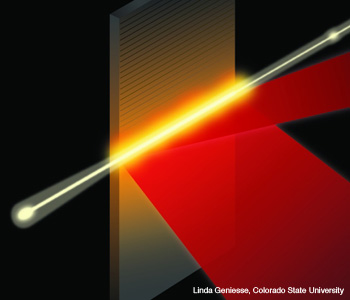 Artist’s rendering of a phase-coherent soft X-ray laser beam. Courtesy of Jorge J. Rocca et al. NSF Engineering Research Center for Extreme Ultraviolet Science and Technology, Colorado State University, U.S.A. Art by Linda Geniesse.
Artist’s rendering of a phase-coherent soft X-ray laser beam. Courtesy of Jorge J. Rocca et al. NSF Engineering Research Center for Extreme Ultraviolet Science and Technology, Colorado State University, U.S.A. Art by Linda Geniesse.
This special issue of Optics & Photonics News (OPN) highlights the most exciting research to emerge in the preceding 12 months in the fast-paced world of optics. Optics in 2008 offers readers a unique opportunity to access, in a single source, summaries of cutting-edge optics research reported in the peer-reviewed press. The areas covered in 2008 include beam engineering, biophotonics, diffractive structures, lasers, material processing, microscopy, nonlinear optics, optical engineering, optical storage, optical tweezers, plasmonics, quantum optics, remote sensing, scattering, terahertz technology, ultrafast optics and nano-optics.
This year’s issue comprises 30 summaries representing the work of more than 140 authors from 13 countries. Submissions were judged on the basis of the following criteria:
• The accomplishments described must have been published in a refereed journal in the year prior to publication in OPN.
• The work should be illustrated in a clear, concise manner that is readily accessible to the at-large optics community.
• The authors should describe the topical area as a whole and then discuss the importance of their work in that context.
Although OPN makes every effort to ensure that achievements in all optics subfields are recognized, there are no requirements in the selection process for inclusion of specific topical areas. When we receive a large number of submissions for a specific area, it is taken as evidence that the topic has been fertile ground for activity and research. OPN strives to ensure that engineering, science and technology are all represented.
This year's summaries
Beam Engineering
By properly shaping the waveform, we can now control the diffraction of light.
Biophotonics
Optics has provided key tools for advancing modern and traditional biology. Now it may play a role in reducing medical costs.
Diffractive Structures
Photonic structures began in the search for localization associated with defects. Now, however, localized states have been demonstrated in defect-free media.
Lasers
We have created lasers with operating properties that we never would have dreamed of when the technology was invented 50 years ago.
Material Processing
Short optical pulses provide useful material
processing capability.
Microscopy
We continue to find new performance enhancements even for mature technologies like optical microscopy.
Nano-optics
The coupling of micro-fluidics and array imaging opens a fascinating area of research.
Nonlinear Optics
Nonlinear optical response has enhanced our ability
to produce coherent light throughout the optical spectral region.
Optical Engineering
New waveform generation provides the experimentalist with interesting new tools.
Optical Storage
Temporal storage of optical signals is a needed capability in communications.
Optical Tweezers
First discovered in 1970, optical tweezers can now be generated and controlled.
Plasmonics
Electron-spin-based photonic devices are a hot topic in optical research.
Quantum Optics
It is now possible to conduct optical experiments on systems that exhibit strongly correlated behavior.
Remote Sensing
We continue to develop more sensitive systems for the remote sensing of biological and chemical trace components.
Scattering
We have missed the presence of resonant scattering behavior in the Rayleigh region for years, but a clue was lurking in quantum theory.
Terahertz Technology
This frequency range has had a variety of names since the 1960s, and researchers continue to be interested in exploiting this spectral region.
Ultrafast Optics
We describe a novel short pulse laser system.
OPN and OSA would like to thank all the researchers from around the world who submitted summaries, as well as to our panel chair and guest editors.
